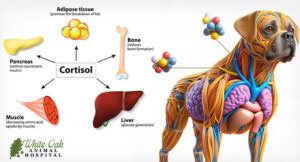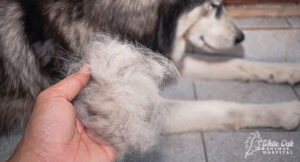
Dog Cushing’s disease, also known as hyperadrenocorticism, is a condition where the adrenal glands produce excessive cortisol hormone. This hormonal imbalance disrupts the body’s normal functions, leading to various health issues in affected dogs. The disease is commonly caused by either a tumor in the pituitary gland, known as pituitary-dependent Cushing’s disease or a tumor in the adrenal glands, referred to as adrenal-dependent Cushing’s Disease.
Both forms result in the overproduction of cortisol, harming a dog’s overall health and well-being. Symptoms may include increased thirst and urination, excessive hunger, hair loss, and muscle weakness. Understanding the causes and symptoms of dog Cushing’s disease is crucial for prompt diagnosis and effective management, ensuring the best possible outcome for your furry companion.
What is Dog Cushing’s Disease?
 Dog Cushing’s disease, often referred to as hyperadrenocorticism, is a condition marked by the excessive production of cortisol hormone. Cortisol, commonly known as the stress hormone, serves essential bodily functions, such as regulating metabolism, managing stress responses, and controlling inflammation. However, in dogs with Cushing’s disease, there is an abnormal elevation of cortisol levels, disrupting the body’s equilibrium.
Dog Cushing’s disease, often referred to as hyperadrenocorticism, is a condition marked by the excessive production of cortisol hormone. Cortisol, commonly known as the stress hormone, serves essential bodily functions, such as regulating metabolism, managing stress responses, and controlling inflammation. However, in dogs with Cushing’s disease, there is an abnormal elevation of cortisol levels, disrupting the body’s equilibrium.
This hormonal imbalance typically arises from tumors affecting either the pituitary gland (resulting in pituitary-dependent Cushing’s disease) or the adrenal glands (leading to adrenal-dependent Cushing’s disease). These tumors prompt the glands to overproduce cortisol, leading to a cascade of symptoms and health issues in affected dogs.
Symptoms of dog Cushing’s disease can include increased thirst and urination, excessive hunger, hair loss, muscle weakness, and a pot-bellied appearance. Recognizing these signs is crucial for timely diagnosis and intervention. By understanding the role of cortisol and its dysregulation in dog Cushing’s disease, pet owners can better comprehend the condition and collaborate with veterinarians to ensure optimal care for their furry companions.
Common Symptoms of Dog Cushing’s Disease
 Excessive Thirst and Urination
Excessive Thirst and Urination
One of the hallmark symptoms of dog Cushing’s disease is increased thirst (polydipsia) and urination (polyuria). dog Cushing’s disease may exhibit a noticeable increase in water consumption, often accompanied by frequent and excessive urination. This occurs due to the effects of elevated cortisol levels on the kidneys, leading to impaired water reabsorption and increased urine production. Pet owners may observe their dogs drinking from water sources more frequently and needing to go outside for bathroom breaks more often than usual.
Increased Appetite
Another common symptom of dog Cushing’s disease is an insatiable appetite, known as polyphagia. Dogs affected by Cushing’s disease may display an uncharacteristic gluttony for food, seemingly always hungry and eager to eat. This excessive hunger can lead to weight gain and contribute to other symptoms associated with the condition. Pet owners may notice their dogs constantly begging for food, raiding trash cans, or exhibiting food-seeking behaviors even shortly after being fed.
Hair Loss and Thinning Coat
 Hair loss (alopecia) and a thinning coat are prevalent signs of Dog Cushing’s Disease, often affecting the trunk, tail, and areas where the coat is typically thick. Excessive cortisol levels disrupt the normal growth cycle of hair follicles, leading to hair loss and a dull, patchy coat appearance. Pet owners may observe bald patches, thinning hair, or changes in the texture and quality of their dog’s fur. The skin may become fragile and prone to bruising or developing lesions.
Hair loss (alopecia) and a thinning coat are prevalent signs of Dog Cushing’s Disease, often affecting the trunk, tail, and areas where the coat is typically thick. Excessive cortisol levels disrupt the normal growth cycle of hair follicles, leading to hair loss and a dull, patchy coat appearance. Pet owners may observe bald patches, thinning hair, or changes in the texture and quality of their dog’s fur. The skin may become fragile and prone to bruising or developing lesions.
Pot-Bellied Appearance
Dogs with Cushing’s disease may develop a characteristic pot-bellied appearance, where the abdomen appears distended or swollen. This abdominal enlargement, known as hepatomegaly or hepatomegaly, results from several factors, including muscle weakness, fat redistribution, and fluid accumulation in the abdominal cavity (ascites). The combination of increased appetite, muscle weakness, and altered fat metabolism contributes to the development of this distinctive abdominal bulge. Pet owners may notice their dogs’ bellies protruding or appearing disproportionately larger compared to the rest of their bodies.
Muscle Weakness and Lethargy
 Muscle weakness and lethargy are common symptoms experienced by dogs with Cushing’s disease, affecting their overall mobility and energy levels. Elevated cortisol levels can lead to muscle wasting and weakness, resulting in reduced stamina, reluctance to exercise, and difficulty performing everyday activities. Dogs may appear sluggish, tired, or unwilling to engage in physical activities they previously enjoyed. Pet owners may observe their dogs moving more slowly, struggling to climb stairs or jump onto furniture, and showing less interest in play or walks.
Muscle weakness and lethargy are common symptoms experienced by dogs with Cushing’s disease, affecting their overall mobility and energy levels. Elevated cortisol levels can lead to muscle wasting and weakness, resulting in reduced stamina, reluctance to exercise, and difficulty performing everyday activities. Dogs may appear sluggish, tired, or unwilling to engage in physical activities they previously enjoyed. Pet owners may observe their dogs moving more slowly, struggling to climb stairs or jump onto furniture, and showing less interest in play or walks.
Dog Cushing’s disease can manifest through various symptoms, including excessive thirst and urination, increased appetite, hair loss, a pot-bellied appearance, muscle weakness, and lethargy. Pet owners should remain vigilant for these signs and promptly consult with a veterinarian if they suspect their dog may be affected by Cushing’s disease. Early detection and intervention can significantly improve the prognosis and quality of life for dogs with this condition.
Diagnosing Dog Cushing’s Disease
Diagnosing Cushing’s disease in dogs involves a combination of clinical evaluation and diagnostic tests conducted by veterinarians. These tests aim to confirm the presence of elevated cortisol levels and identify the underlying cause of the condition.
 Veterinarians typically employ a variety of diagnostic tests to assess dogs suspected of having Cushing’s disease. Blood tests, such as the low-dose dexamethasone suppression test (LDDST) or the adrenocorticotropic hormone (ACTH) stimulation test, measure cortisol levels in the blood before and after administering certain medications. Urine tests may also be conducted to evaluate cortisol levels over 24 hours. Additionally, imaging techniques such as ultrasound or radiography may be used to visualize the adrenal glands and identify abnormalities, such as tumors.
Veterinarians typically employ a variety of diagnostic tests to assess dogs suspected of having Cushing’s disease. Blood tests, such as the low-dose dexamethasone suppression test (LDDST) or the adrenocorticotropic hormone (ACTH) stimulation test, measure cortisol levels in the blood before and after administering certain medications. Urine tests may also be conducted to evaluate cortisol levels over 24 hours. Additionally, imaging techniques such as ultrasound or radiography may be used to visualize the adrenal glands and identify abnormalities, such as tumors.
Differential diagnosis is crucial in the diagnostic process for Dog Cushing’s disease to distinguish it from other conditions with similar symptoms. Conditions such as diabetes mellitus, kidney disease, liver disease, and certain infections can also present with increased thirst, urination, and appetite. By ruling out other potential causes of the symptoms, veterinarians can accurately diagnose Cushing’s disease and develop an appropriate treatment plan tailored to the dog’s needs.
Breeds Prone to Developing Dog Cushing’s Disease
Certain dog breeds exhibit a higher predisposition to developing Cushing’s disease, although the condition can affect dogs of any breed and age. Understanding these breed predispositions can aid pet owners and veterinarians in early detection and management.
Breeds commonly associated with an increased risk of developing dog Cushing’s disease include Poodles, Dachshunds, Boston Terriers, Boxers, and Yorkshire Terriers. However, it’s essential to note that Cushing’s disease can occur in mixed-breed dogs and breeds not typically considered predisposed.
Pet owners of breeds with a higher predisposition to dog Cushing’s disease should be vigilant for signs and symptoms and consult their veterinarian if any concerns arise. Early detection and intervention can help mitigate the impact of Cushing’s disease on a dog’s health and quality of life.

If your dog suffers from Cushing’s disease, seeking proper veterinary care is essential to ensure their well-being. At White Oak Animal Hospital, we offer integrative options not available elsewhere, including TCVM Telemedicine consultations and over 28 years of experience treating various conditions, including Cushing’s disease.
 Our holistic TCVM veterinarian Dr. Damron has extensive experience managing Cushing’s Disease and is committed to providing compassionate care tailored to your pet’s needs. From traditional pharmaceuticals to holistic approaches incorporating herbs and diet, we strive to offer comprehensive solutions to help your best friend feel better.
Our holistic TCVM veterinarian Dr. Damron has extensive experience managing Cushing’s Disease and is committed to providing compassionate care tailored to your pet’s needs. From traditional pharmaceuticals to holistic approaches incorporating herbs and diet, we strive to offer comprehensive solutions to help your best friend feel better.
Download our free ebook to learn more about the causes, symptoms, and treatment options for dog Cushing’s disease. Empower yourself with knowledge and make informed decisions about your pet’s health. Together, we can help your dog lead a happier, healthier life.
Frequently Asked Questions
Can Dog Cushing’s Disease be cured?
Unfortunately, dog Cushing’s disease cannot be cured, but it can be managed effectively with proper veterinary care. Treatment options aim to control symptoms and improve your dog’s quality of life.
Is Dog Cushing’s Disease contagious to other pets or humans?
No, dog Cushing’s disease is not contagious. It is a hormonal disorder caused by the overproduction of cortisol and cannot be transmitted to other pets or humans.
Can diet and lifestyle changes help manage Dog Cushing’s Disease?
While diet and lifestyle changes alone may not cure dog Cushing’s disease, they can be supportive in managing symptoms. Consult your veterinarian for personalized dietary recommendations and lifestyle adjustments tailored to your dog’s needs.
How often should my dog be monitored for Dog Cushing’s Disease?
Regular monitoring is essential for dogs diagnosed with Cushing’s disease. Your veterinarian will advise on the frequency of follow-up appointments and diagnostic tests to assess your dog’s response to treatment and adjust management strategies accordingly.
Related Posts
-
Natural Dog Cushing's Disease Treatments
Natural dog Cushing's disease treatments are easy to use and often very successful. It's pretty…
-
Best Dog Cushing’s Herbal Remedies
Dog Cushing’s herbal remedies may benefit your pet. Canine Cushing’s disease is also known as…
-
Understanding Dog Cushing's Disease Treatments
Once your pet has been diagnosed, talk with your vet about options for dog Cushing’s…
-
How to Find the Best Thyroid Supplement for Dogs
If you're looking for the best thyroid supplement for dogs, you've landed on the right…









